Resources
Ghost Hunting Equipment
There are a multitude of tools ghost hunters use to aid their investigations. Some tools are repurposed, pre-existing items that operate on known scientific principles and detect naturally occurring phenomena, while other tools are tailor-made for ghost hunting and operate on the numerous theories about paranormal phenomena. Investigators use this equipment in two ways: To help debunk activity when possible, and to provide additional context for our experiences during investigations. Select each of the three categories below to see what we use.
Click on thumbnails to view larger images.
Ghost Hunting Equipment | Filming Equipment | Misc. Gear
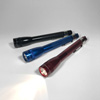 Flashlight — Yep. Just a regular flashlight, particularly the smaller,
twist-on/twist-off style flashlight. This style flashlight is a common ghost hunting tool for
getting interactive responses. The theory is, by twisting the flashlight so that it's just barely
on and then backing it off a bit, a spirit can manipulate it easily to turn it on or off. Further,
by establishing what on and off mean (i.e., yes and no), or by using multiple flashlights,
investigators can have simple conversations with spirits. We got ours on
Amazon,
but they can be found anywhere that sells flashlights.
Flashlight — Yep. Just a regular flashlight, particularly the smaller,
twist-on/twist-off style flashlight. This style flashlight is a common ghost hunting tool for
getting interactive responses. The theory is, by twisting the flashlight so that it's just barely
on and then backing it off a bit, a spirit can manipulate it easily to turn it on or off. Further,
by establishing what on and off mean (i.e., yes and no), or by using multiple flashlights,
investigators can have simple conversations with spirits. We got ours on
Amazon,
but they can be found anywhere that sells flashlights.
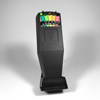 EMF Detector — EMF stands for Electromagnetic Field. A predominate theory
in the world of paranormal research is that spirits need, use, or otherwise interact through
manipulating various types of energy, particularly electromagnetic energy. These tools are the
same basic hardware as electricians' EMF probes, but are typically repackaged in smaller, more
consumer-friendly casings. Once activated, EMF detectors are able to detect nearby electromagnetic
fields within a certain Milligauss range. Typically, ghost hunting EMF detectors have LED indicators
on them, and some might also audibly buzz or beep. We got ours on
Pro-Measure.com.
EMF Detector — EMF stands for Electromagnetic Field. A predominate theory
in the world of paranormal research is that spirits need, use, or otherwise interact through
manipulating various types of energy, particularly electromagnetic energy. These tools are the
same basic hardware as electricians' EMF probes, but are typically repackaged in smaller, more
consumer-friendly casings. Once activated, EMF detectors are able to detect nearby electromagnetic
fields within a certain Milligauss range. Typically, ghost hunting EMF detectors have LED indicators
on them, and some might also audibly buzz or beep. We got ours on
Pro-Measure.com.
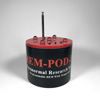 REM Pod — These are purpose-built pieces of ghost hunting hardware, though
similar technology can be used for trip-wire sensors or similar functionality. The "REM" part
stands for "Radiating ElectroMagneticity," and it is kind of the counterpart to the EMF detector.
An antenna on the device emits a small EMF field around it, often only a couple inches in diameter.
If anything (physical or otherwise) interrupts that field, LEDs on the device light up and a buzzer
sounds off. We got ours on Pro-Measure.com.
REM Pod — These are purpose-built pieces of ghost hunting hardware, though
similar technology can be used for trip-wire sensors or similar functionality. The "REM" part
stands for "Radiating ElectroMagneticity," and it is kind of the counterpart to the EMF detector.
An antenna on the device emits a small EMF field around it, often only a couple inches in diameter.
If anything (physical or otherwise) interrupts that field, LEDs on the device light up and a buzzer
sounds off. We got ours on Pro-Measure.com.
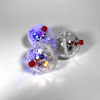 Cat Ball — These are literally just cat toys that light up when they detect
impact. The sensor inside is sensitive enough to detect fairly light impact, so they are ideal for
kinetic energy types of testing during paranormal investigations. The theory behind it is that since
the sensor is highly sensitive, it shouldn't take a lot of energy for a spirit to interact with it.
They have become so ubiquitous in paranormal investigation that online shops are even beginning to
market them as ghost hunting equipment. We got ours on
Amazon
in a 6-pack for fairly cheap.
Cat Ball — These are literally just cat toys that light up when they detect
impact. The sensor inside is sensitive enough to detect fairly light impact, so they are ideal for
kinetic energy types of testing during paranormal investigations. The theory behind it is that since
the sensor is highly sensitive, it shouldn't take a lot of energy for a spirit to interact with it.
They have become so ubiquitous in paranormal investigation that online shops are even beginning to
market them as ghost hunting equipment. We got ours on
Amazon
in a 6-pack for fairly cheap.
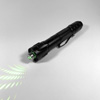 Laser Grid — There are several form factors of this device available these days,
but ours is the more traditional laser pointer style. The core element of the laser grid is a projected
laser filtered through a cap that splits it into an adjustable grid of dots. These are used as a visual
aid when watching for movement or filming an environment. Should something move around inside the space
in which the laser is projected, the lasers will be interrupted and you'll see the laser dots move about
in space. We got ours as a gift from a family member who works with
the Wichita Paranormal Research Society,
but you can find a similar one available at GhostStop.
Laser Grid — There are several form factors of this device available these days,
but ours is the more traditional laser pointer style. The core element of the laser grid is a projected
laser filtered through a cap that splits it into an adjustable grid of dots. These are used as a visual
aid when watching for movement or filming an environment. Should something move around inside the space
in which the laser is projected, the lasers will be interrupted and you'll see the laser dots move about
in space. We got ours as a gift from a family member who works with
the Wichita Paranormal Research Society,
but you can find a similar one available at GhostStop.
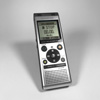 Voice Recorder — One of the more famous pieces of ghost hunting equipment is
the voice recorder. For decades, recording equipment of all types had been found to pick up unintended
audio. Currently, the best voice recorder known for picking up EVP (electronic voice phenomena) is the
Panasonic RR-DR60 from the late 1990s. When Panasonic put these out, users were finding "extra voices"
in the recordings, audio that wasn't present at the time of recording. These users are thought have been
unwittingly picking up EVPs of a paranormal nature. Panasonic then put out a "fixed" version, and the
DR60 then became the rare, must-have voice recorder. You can find them on eBay for a few thousand dollars.
We don't have that kind of money, so we got an Olympus WS-852 from
GhostStop
instead, as recommended by a family member who works with the
Wichita Paranormal Research Society.
Voice Recorder — One of the more famous pieces of ghost hunting equipment is
the voice recorder. For decades, recording equipment of all types had been found to pick up unintended
audio. Currently, the best voice recorder known for picking up EVP (electronic voice phenomena) is the
Panasonic RR-DR60 from the late 1990s. When Panasonic put these out, users were finding "extra voices"
in the recordings, audio that wasn't present at the time of recording. These users are thought have been
unwittingly picking up EVPs of a paranormal nature. Panasonic then put out a "fixed" version, and the
DR60 then became the rare, must-have voice recorder. You can find them on eBay for a few thousand dollars.
We don't have that kind of money, so we got an Olympus WS-852 from
GhostStop
instead, as recommended by a family member who works with the
Wichita Paranormal Research Society.
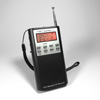 Spirit Box / Estes Method — You may find specific products called "Spirit Boxes,"
but the term refers to radio-derived devices used for purportedly picking up audio influenced by spirits.
They originated as regular radios that had been modified to cycle through stations rapidly, and have since
evolved into purpose-built, hand-held devices with tunable features. Much like the theory of spirits
interacting with EMF energy, the theory here is that spirits might be able to communicate through radio
frequency. Spirit Boxes can be used well enough with the built-in speaker, but in recent years the
Estes Method has added a few more elements. The Estes Method was created by Karl Pfeiffer
at the Stanley Hotel (in Estes Park, Colorado) as an alternate means of using a Spirit Box
by integrating sensory deprivation. The idea is that the user can focus more fully on the radio static audio,
and some investigators think the sensory deprivation helps induce a trance-like state where the user's perception
of the audio is more effective. We got our Spirit Box from
GhostStop
with noise cancelling headphones
and blackout sleep masks from Amazon.
Spirit Box / Estes Method — You may find specific products called "Spirit Boxes,"
but the term refers to radio-derived devices used for purportedly picking up audio influenced by spirits.
They originated as regular radios that had been modified to cycle through stations rapidly, and have since
evolved into purpose-built, hand-held devices with tunable features. Much like the theory of spirits
interacting with EMF energy, the theory here is that spirits might be able to communicate through radio
frequency. Spirit Boxes can be used well enough with the built-in speaker, but in recent years the
Estes Method has added a few more elements. The Estes Method was created by Karl Pfeiffer
at the Stanley Hotel (in Estes Park, Colorado) as an alternate means of using a Spirit Box
by integrating sensory deprivation. The idea is that the user can focus more fully on the radio static audio,
and some investigators think the sensory deprivation helps induce a trance-like state where the user's perception
of the audio is more effective. We got our Spirit Box from
GhostStop
with noise cancelling headphones
and blackout sleep masks from Amazon.
 XLS Camera — We've known about the SLS Camera for quite a while now, but we recently
discovered there is an upgraded model. The earlier incarnation, the SLS Camera, operates by using
the onboard Xbox Kinect camera hardware to detect human forms and track their overall body movements as it would
normally in Xbox Kinect games. However, instead of providing controls/instructions from that tracked movement to the
Xbox operating system, the SLS Camera software instead projects that form onto a visual, 2-dimensional slate that can
be viewed on screen in realtime. As expected, it tracks humans wonderfully, but if it tracks the human form when someone
is NOT in front of the camera, that's when it gets interesting. One major flaw, though, is that the SLS camera software
can show false positives if the Kinect camera's IR beams hit a reflective surface. That's where this upgraded model,
the XLS Camera, comes in. The XLS adds an additional bit of hardware and software, integrating a
LiDAR feature that introduces 3D mapping into the mix. Instead of a 2-dimensional visual projection, the screen now
displays a 3-dimensional space with depth data. Not only does the 3D mapping help in showing where a figure might be
in better spacial context, it can significantly reduce the false positives that might show up on an SLS Camera by
discerning whether the incoming IR data is a human figure or just noise across multiple surfaces. We got this from
Horn Paranormal,
and we even had them customize it with our name embedded in the 3D printed shell.
XLS Camera — We've known about the SLS Camera for quite a while now, but we recently
discovered there is an upgraded model. The earlier incarnation, the SLS Camera, operates by using
the onboard Xbox Kinect camera hardware to detect human forms and track their overall body movements as it would
normally in Xbox Kinect games. However, instead of providing controls/instructions from that tracked movement to the
Xbox operating system, the SLS Camera software instead projects that form onto a visual, 2-dimensional slate that can
be viewed on screen in realtime. As expected, it tracks humans wonderfully, but if it tracks the human form when someone
is NOT in front of the camera, that's when it gets interesting. One major flaw, though, is that the SLS camera software
can show false positives if the Kinect camera's IR beams hit a reflective surface. That's where this upgraded model,
the XLS Camera, comes in. The XLS adds an additional bit of hardware and software, integrating a
LiDAR feature that introduces 3D mapping into the mix. Instead of a 2-dimensional visual projection, the screen now
displays a 3-dimensional space with depth data. Not only does the 3D mapping help in showing where a figure might be
in better spacial context, it can significantly reduce the false positives that might show up on an SLS Camera by
discerning whether the incoming IR data is a human figure or just noise across multiple surfaces. We got this from
Horn Paranormal,
and we even had them customize it with our name embedded in the 3D printed shell.